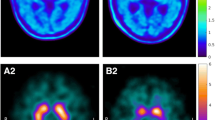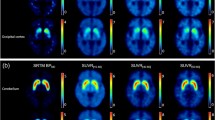Abstract
Purpose
18F-FP-CIT [18F-fluorinated N-3-fluoropropyl-2-beta-carboxymethoxy-3-beta-(4-iodophenyl) nortropane] has been well established and used for the differential diagnosis of atypical parkinsonian disorders. Recently, combined positron emission tomography (PET)/magnetic resonance (MR) was proposed as a viable alternative to PET/computed tomography (CT). The aim of this study was to compare the performances of conventional 18F-FP-CIT brain PET/CT and simultaneous PET/MR by visual inspection and quantitative analysis.
Methods
Fifteen consecutive patients clinically suspected of having Parkinson’s disease were recruited for the study.18F-FP-CIT PET was performed during PET/CT and PET/MR. PET/CT image acquisition was started 90 min after intravenous injection of 18F-FP-CIT and then PET/MR images were acquired. Dopamine transporter (DAT) density in bilateral striatal subregions was assessed visually. Quantitative analyses were performed on bilateral striatal volumes of interest (VOIs) using average standardized uptake values (SUVmeans). Intraclass correlation coefficients (ICCs) and their 95 % confidence intervals (CIs) were assessed to compare PET/CT and PET/MR data. Bland–Altman plots were drawn to perform method-comparisons.
Results
All subjects showed a preferential decrease in DAT binding in the posterior putamen (PP), with relative sparing of the ventral putamen (VP). Bilateral striatal subregional binding ratio (BR) determined PET/CT and PET/MR demonstrated close interequipment correspondence (BRright caudate - ICC, 0.944; 95 % CI, 0.835–0.981, BRleft caudate - ICC, 0.917; 95 % CI, 0.753–0.972, BRright putamen - ICC, 0.976; 95 % CI, 0.929–0.992 and BRleft putamen - ICC, 0.970; 95 % CI, 0.911–0.990, respectively), and Bland–Altman plots showed interequipment agreement between the two modalities.
Conclusions
It is known that MR provides more information about anatomical changes associated with brain diseases and to enable the anatomical allocations of subregions than CT, though this was not observed in the present study. Although the subregional BR of simultaneous PET/MR was comparable to that of PET/CT in Parkinson’s disease, our isocontouring method could make bias. A future automated method using standard template study or manual segmentation of putamen/caudate based on MR or CT is needed.





Similar content being viewed by others
References
Lang AE, Lozano AM. Parkinson’s disease. 1st of two parts. N Engl J Med. 1998;339:1044–53.
Lang AE, Lozano AM. Parkinson’s disease. 2nd of two parts. N Engl J Med. 1998;339:1130–43.
Hughes AJ, Daniel SE, Lees AJ. The clinical features of Parkinson’s disease in 100 histologically proven cases. Adv Neurol. 1993;60:595–9.
Bower JH, Dickson DW, Taylor L, et al. Clinical correlates of the pathology underlying parkinsonism: a population perspective. Mov Disord. 2002;17:910–6.
Juh R, Kim J, Moon D, Choe B, Suh T. Different metabolic patterns analysis of Parkinsonism on the 18F-FDG PET. Eur J Radiol. 2004;51:223–33.
Van Laere K, Casteels C, De Ceuninck L, Vanbilloen B, Maes A, Mortelmans L, et al. Dual-tracer dopamine transporter and perfusionSPECT in differential diagnosis of parkinsonism using templatebaseddiscriminant analysis. J Nucl Med. 2006;47:384–92.
Schocke MF, Seppi K, Esterhammer R, Kremser C, Jaschke W, Poewe W, et al. Diffusion-weighted MRI differentiates the Parkinson variant of multiple system atrophy from PD. Neurology. 2002;58:575–80.
Cherry SR. Fundamentals of positron emission tomography and applications inpreclinical drug development. J Clin Pharmacol. 2001;41:482–91.
Jokinen P, Helenius H, Rauhala E, et al. Simple ratio analysis of 18F-fluorodopauptake in striatal subregions separates patients with early Parkinson disease from healthy controls. J Nucl Med. 2009;50:893–9.
Martinez-Möller A, Eiber M, Nekolla SG, et al. Workflow and scan protocol considerations for integrated whole-body PET/MRI in oncology. J Nucl Med. 2012;53:1415–26.
Drzezga A, Souvatzoglou M, Eiber M, et al. First clinical experience with integrated whole-body PET/MR: comparison to PET/CT in patients with oncologic diagnoses. J Nucl Med. 2012;53:845–55.
Antoch G, Bockisch A. Combined PET/MRI: a new dimension in whole-bodyoncology imaging? Eur J Nucl Med Mol Imaging. 2009;36:S113–20.
Loeffelbein DJ, Souvatzoglou M, Wankerl V, et al. PET-MRI fusion in head-and neck oncology: current status and implications for hybrid PET/MRI. J Oral Maxillofac Surg. 2012;70:473–83.
von Schulthess GK, Schlemmer HP. A look ahead: PET/MR versus PET/CT. Eur J Nucl Med Mol Imaging. 2009;36:S3–9.
Schinagl DA, Span PN, van den Hoogen FJ, et al. Pathology-based validation of FDG PET segmentation tools for volume assessment of lymph node metastases from head and neck cancer. Eur J Nucl Med Mol Imaging. 2013;40(12):1828–35.
Zhang S, Xin J, Guo Q, et al. Defining PET tumor volume in cervical cancer with hybrid PET/MRI: a comparative study. Nucl Med Commun. 2014;35(7):712–9.
Choi H, Cheon GJ, Kim HJ, et al. Segmentation-based MR attenuation correction including bones also affects quantitation in brain studies: an initial result of 18F-FP-CIT PET/MR for patients with parkinsonism. J Nucl Med. 2014;55:1617–22.
Landis JR, Koch GG. The measurement of observer agreement for categorical data. Biometrics. 1977;33:159–74.
Eliasziw M, Young SL, Woodbury MG, Fryday-Field K. Statistical methodology for the concurrent assessment of interrater and intrarater reliability: using goniometric measurements as an example. Phys Ther. 1994;74:777–88.
Dewitte K, Fierens C, Stöckl D, Thienpont LM. Application of the Bland-Altman plot for the interpretation of method-comparison studies: a critical investigation of its practice. Clin Chem. 2002;48:799–801.
Mantha S, Roizen MF, Fleisher LA, Thisted R, Foss J. Comparing methods of clinical measurement: reporting standards for Bland and Altman analysis. Anesth Analg. 2000;90:593–602.
Kim BS, Jang SJ, Eo JS, Park EK, Kim YK, Kim JM, et al. The discriminating nature of dopamine transporter image in parkinsonism: the competency of dopaminergic transporter imaging in differential diagnosis of parkinsonism: 123I-FP-CIT SPECT study. Nucl Med Mol Imaging. 2007;41:272–9.
Oh SW, Kim YK, Lee BC, Kim BS, Kim JS, Kim JM, et al. Evaluation of multiple system atrophy and early Parkinson’s disease using 123I-FP-CIT SPECT. Nucl Med Mol Imaging. 2009;43:10–8.
Ma Y, Dhawan V, Mentis M, et al. Parametric mapping of [18F]FPCIT binding in early stage Parkinson’s disease: a PET study. Synapse. 2002;45:125–33.
Hofmann M, Pichler B, Scholkopf B, Beyer T. Towards quantitative PET/MRI: a review of MR-based attenuation correction techniques. Eur J Nucl Med Mol Imaging. 2009;36:S93–104.
Eiber M, Takei T, Souvatzoglou M, et al. Performance of whole-body integrated 18F-FDG PET/MR in comparison to PET/CT for evaluation of malignant bone lesions. J Nucl Med. 2014;55:191–7.
Rauscher I, Eiber M, Furst S, et al. PET/MR imaging in the detection and characterization of pulmonary lesions: technical and diagnostic evaluation in comparison to PET/CT. J Nucl Med. 2014;55:724–9.
Iranzo A, Valldeoriola F, Lomena F, et al. Serial dopamine transporter imaging of nigrostriatal function in patients with idiopathic rapid-eye-movement sleep behavior disorder: a prospective study. Lancet Neurol. 2011;10:797–805.
Schapira AH, McDermott MP, Barone P, et al. Pramipexole in patients with early Parkinson’s disease (PROUD): a randomised delayed-start trial. Lancet Neurol. 2013;12:747–55.
Yaqub M, Boellaard R, van Berckel BN, et al. Quantification of dopamine transporter binding using [18F]FP-beta-CIT and positron emission tomography. J Cereb Blood Flow Metab. 2007;27:1397–406.
Scherfler C, Seppi K, Donnemiller E, et al. Voxel-wise analysis of [123I]beta-CIT SPECT differentiates the Parkinson variant of multiple system atrophy from idiopathic Parkinson’s disease. Brain. 2005;128:1605–12.
Kim YI, Im HJ, Paeng JC, et al. Validation of Simple Quantification Methods for (18)F-FP-CIT PET Using Automatic Delineation of Volumes of Interest Based on Statistical Probabilistic Anatomical Mapping and Isocontour Margin Setting. Nucl Med Mol Imaging. 2012;46(4):254–60.
Soyoung Jin, Minyoung Oh, Seung Jun Oh et al. Differential Diagnosis of Parkinsonism Using Dual-Phase F-18 FP-CIT PET Imaging. Nucl Med Mol Imaging. 2013;47:44–51.
Delso G, Furst S, Jakoby B, et al. Performance measurements of the Siemens mMR integrated whole-body PET/MR scanner. J Nucl Med. 2011;52:1914–22.
Oh M, Kim JS, Kim JY, et al. Subregional patterns of preferential striatal dopamine transporter loss differ in Parkinson disease, progressive supranuclear palsy, and multiple-system atrophy.J Nucl Med. 2012;53(3):399–-406.
Adams MC, Turkington TG, Wilson JM, et al. A systematic review of the factors affecting accuracy of SUV measurements. AJR Am J Roentgenol. 2010;195(2):310–20.
Boellaard R, Oyen WJ, Hoekstra CJ, et al. The Netherlands protocol for standardisation and quantification of FDG whole body PET studies in multi-centre trials. Eur J Nucl Med Mol Imaging. 2008;35(12):2320–33.
Biehl KJ, Kong FM, Dehdashti F, et al. 18F-FDG PET definition of gross tumor volume for radiotherapy of non-small cell lung cancer: is a single standardized uptake value threshold approach appropriate? J Nucl Med. 2006;47(11):1808–12.
Acknowledgments
None. No funding to declare.
Author information
Authors and Affiliations
Corresponding author
Ethics declarations
Conflict of Interest
SangDon Kwon, Eunjung Kong, KyungAh Chun and IhnHo Cho declare that they have no conflict of interest.
Ethical Statement
All procedures performed in the study involving human participant were in accordance with the ethical standards of the institutional research committee and with the 1964 Helsinki declaration and its later amendments or comparable ethical standards.
Additional information
This manuscript has not been published before or is not under consideration for publication anywhere else and has been approved by all co-authors.
Rights and permissions
About this article
Cite this article
Kwon, S., Chun, K., Kong, E. et al. Comparison of the Performances of 18F-FP-CIT Brain PET/MR and Simultaneous PET/CT: a Preliminary Study. Nucl Med Mol Imaging 50, 219–227 (2016). https://doi.org/10.1007/s13139-016-0419-8
Received:
Revised:
Accepted:
Published:
Issue Date:
DOI: https://doi.org/10.1007/s13139-016-0419-8




